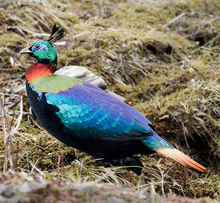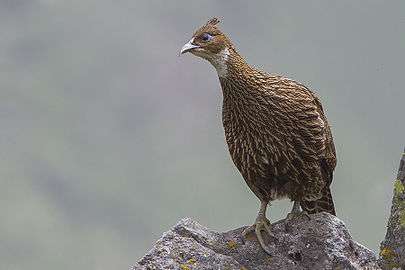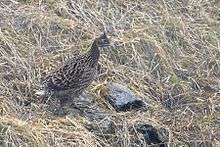Himalayan monal
The Himalayan monal (Lophophorus impejanus), also known as the Impeyan monal and Impeyan pheasant, is a pheasant native to Himalayan forests and shrublands at elevations of 2,100–4,500 m (6,900–14,800 ft). It is part of the family Phasianidae and is listed as Least Concern on the IUCN Red List.[1] It is the national bird of Nepal, where it is known as the danphe or danfe,[2] and state bird of Uttarakhand, India, where it is known as the monal.[3][4] It was also the state bird of Himachal Pradesh until 2007.[5]
| Himalayan monal | |
|---|---|
 | |
| Male | |
 | |
| Female | |
| Scientific classification | |
| Kingdom: | Animalia |
| Phylum: | Chordata |
| Class: | Aves |
| Order: | Galliformes |
| Family: | Phasianidae |
| Genus: | Lophophorus |
| Species: | L. impejanus |
| Binomial name | |
| Lophophorus impejanus (Latham, 1790) | |
The scientific name commemorates Lady Mary Impey, the wife of the British chief justice of Bengal, Sir Elijah Impey.
Description

It is a relatively large-sized pheasant. The bird is about 70 cm (28 in) long. The male weighs up to 2,380 g (84 oz) and the female 2,150 g (76 oz). The adult male has multicoloured plumage throughout, while the female, as in other pheasants, is more subdued in colour. Notable features in the male include a long, metallic green crest, coppery feathers on the back and neck, and a prominent white rump that is most visible when the bird is in flight. The tail feathers of the male are uniformly rufous, becoming darker towards the tips, whereas the lower tail coverts of females are white, barred with black and red. The female has a prominent white patch on the throat and a white strip on the tail. The first-year male and the juvenile resemble the female, but the first-year male is larger and the juvenile is less distinctly marked.
Distribution and habitat
The Himalayan monal's native range extends from Afghanistan and Pakistan through the Himalayas in India, Nepal, southern Tibet, and Bhutan.[1] In Pakistan, it is most common in the Khyber Pakhtunkhwa province and has also been recorded in Kaghan, Palas Valley, and Azad Kashmir.[6] It lives in upper temperate oak-conifer forests interspersed with open grassy slopes, cliffs and alpine meadows between 2400 and 4500 meters, where it is most common between 2700 and 3700 meters. It descends to 2,000 m (6,600 ft) in the winter. It tolerates snow and digs through it to obtain plant roots and invertebrate prey.
Behaviour and ecology
The breeding season is April through August, and they generally form pairs at this time. In winter they congregate in large coveys and roost communally.
Conservation
In some areas, the species is threatened due to poaching and other anthropogenic factors. In the western Himalayas, the local monal population responded negatively to human disturbance involving hydroelectric power development.[7] The male monal was under hunting pressure in Himachal Pradesh, where the crest feather was used to decorate men's hats, until 1982, when hunting was banned in the state.
The pheasant is not considered endangered in Pakistan and can be easily located. In some areas, the population density of the species is as high as five pairs per square mile. The main threat to the species is poaching, as the crest is valuable. It is thought to bring status to its wearer and is a symbol of authority.[6]
Gallery
References
- BirdLife International (2016). "Lophophorus impejanus". IUCN Red List of Threatened Species. 2016: e.T22679182A92806166.
- "Animal stories: Danfe". The Himalayan Times. 2007. Retrieved 2019-12-03.
- "Archived copy". Garhwal Mandal Vikas Nigam. Government of Uttarakhand. Archived from the original on 2013-07-15. Retrieved 2012-04-01.CS1 maint: archived copy as title (link)
- Goswami, Amrita (9 October 2012). "सबसे सुंदर पंछियों में से एक मोनाल" [Monal is one of the most beautiful birds]. Prabha Sakshi (in Hindi). Archived from the original on 12 April 2013.
- "Western tragopan is state bird". The Tribune. 17 October 2016.
- "Himalayan Monal". Pheasants of Pakistan. Wildlife of Pakistan. Retrieved 24 February 2013.
- Jolli, V. and Pandit, M. K. (2011). Influence of human disturbance on the abundance of Himalayan Pheasant (Aves, Galliformes) in the temperate forest of Western Himalaya, India. Vestnik Zoologii 45(6): e40-e47.doi:10.2478/v10058-011-0035-0
External links
| Wikimedia Commons has media related to Lophophorus impejanus. |



.jpg)
.jpg)
_(cropped).jpg)